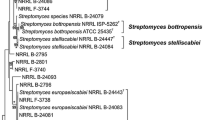Abstract
Type strains of 10 genotypically distinctSaccharomyces species are differentiated by ribosomal DNA restriction fragment analysis (ribotyping). The full length of the chromosomal ribosomal repeat was amplified in two parts, the 18SrDNA including both ITS regions (2600 bp) and the 25SrDNA (3300 bp). Restriction fragments generated by 9 enzymes from these two products yield characteristic patterns, by which unknownSaccharomyces isolates are assigned to the type strains. For convenient separation and detection only fragments longer than 200 bp were monitored. In contrast to molecular differentiation methods of highest resolution as RAPD-PCR or fingerprinting, the results from ribotyping are absolutely reproducible and thereby suitable for databases. The phylogeny computed from the discrete character matrix for presence/absence of fragments by the PHYLIP program package is in complete accordance to the phylogeny derived from ribosomal RNA sequence analysis. By this the field of application of the long range ribotyping can be regarded basically as equal to DNA sequence analysis of the same locus. Because distant relationships are recognized, missidentified genera were detected upon the species assignment. This cannot be done by methods of higher resolution like RAPD-PCR or fingerprinting.
Similar content being viewed by others
References
Barnes WM (1994) PCR amplification of up to 35-kb DNA with high fidelity and high yield from lambda bacteriophage templates. PNAS 91: 2216–2220
Barnett JA, Payne RW & Yarrow D (1990) Yeast: Characteristics and Identification, Second Edition. Cambridge University Press, USA
Barnett JA (1992) The taxonomy of the genusSaccharomyces Meyenex Reess: a short review for non-taxonomists. Yeast 8: 1–23
Felsenstein J (1989) PHYLIP — Phylogeny inference package (version 3.2). Cladistics 5: 164–166
Gruber F, Visser J, Kubicek CP & Graaff LH de (1990) The development of a heterologous transformation system for the cellulolytic fungusTrichoderma reesei based on apyrG-negative mutant strain. Curr. Genet. 18: 71–76
Kurtzman CP & Robnett CJ (1991) Phylogenetic relationships among species ofSaccharomyces, Schizosaccharomyces, Debaryomyces andSchwanniomyces determined from partial ribosomal RNA sequences. Yeast 7: 61–72
Kurtzman CP (1993) rRNA sequence comparisons for assessing phylogenetic relationships among yeasts. Int. J. Syst. Bacteriol. 42: 1–6
Lieckfeldt E, Meyer W & Börner T (1993) Rapid identification and differentiation of yeasts by DNA and PCR fingerprinting. J. Basic Microbiol. 33: 413–426
Lodder J & Kreger-van Rij NJW (1952) The yeast, a taxonomic study. North Holland Publishing Company, Amsterdam
Messner R, Prillinger H, Altman F, Lopandic K, Wimmer K, Molnar O & Weigang F (1994) Molecular characterization and application of Random Amplified Polymorphic DNA analysis onMrakia andSterigmatomyces species. Int. J. Syst. Bacteriol. 44: 694–703
Molina FI, Inoue T & Jong S-C (1992a) Ribosomal DNA restriction analysis reveals genetic heterogeneity inSaccharomyces cerevisiae Meyenex Hansen. Int. J. Syst. Bacteriol. 42: 499–502
—— (1992b) Restriction polymorphisms in the internal transcribed spacers and 5.8S rDNA ofSaccharomyces. Curr. Microbiol. 25: 251–255
Molnár O, Messner R, Prillinger H, Stahl U & Slavikova E (1995) Genotypic indentification ofSaccharomyces species using random amplified polymorphic DNA analysis. Syst. Appl. Microbiol. in press
Naumov GI, Naumova ES & Gaillardin C (1993) Genetic and karyotypic identification of wineSaccharomyces bayanus yeasts isolated in France and Italy. System. Appl. Microbiol. 16: 274–279
Welsh J & McClelland M (1990) Fingerprinting genomes using PCR with arbitrary primers. Nucl. Acids Res. 18: 7213–7218
Williams JGK, Kubelik AR, Livak KJ, Rafalski JA & Tingey SV (1990) DNA-polymorphisms amplified by arbitrary primers are useful as genetic markers. Nucl. Acids Res. 18: 6531–6535
White TJ, Bruns TD, Lee S & Taylor J (1990) Amplification and direct sequencing of fungal ribosomal RNA genes for phylogenetics. In: Innis MA, Jelfand DH, Sininski JJ & White TJ (Eds) PCR Protocols. (pp 293–367) Academic Press, San Diego, USA
Author information
Authors and Affiliations
Rights and permissions
About this article
Cite this article
Messner, R., Prillinger, H. Saccharomyces species assignment by long range ribotyping. Antonie van Leeuwenhoek 67, 363–370 (1995). https://doi.org/10.1007/BF00872936
Received:
Accepted:
Issue Date:
DOI: https://doi.org/10.1007/BF00872936




